

CS Unplugged. Certifications - CompuScholar. Breaking Down the 8 Key Concepts of Computational Thinking. Free Coding Bootcamp Prep Course. While making progress in our free courses is the best way to strengthen your application to our Online and In-Person Software Engineering Bootcamps, finishing the full Coding Bootcamp Prep course is not required to apply.

This free course is meant to help you determine whether you want to pursue a lifelong programming career and whether you can successfully learn to code through our teaching techniques and technology. Our admissions team primarily wants to see consistency in how you’re preparing. As soon as you feel ready to commit your time and energy to an immersive program, you’re encouraged to apply to our Online or In-Person Software Engineering Bootcamps available in NYC, Washington D.C., London, Houston, Atlanta, Dallas, Denver, Seattle, and Chicago. Report of a Workshop on the Scope and Nature of Computational Thinking. Reasoning that is taught to all children.

This view mirrors the growing recognition that computational thinking (and not just computation) has begun to influence and shape thinking in many disciplines—Earth sciences, biology, and statistics, for example. Moreover, computational thinking is likely to benefit not only other scientists but also everyone else—bankers, stockbrokers, lawyers, car mechanics, salespeople, health care professionals, artists, and so on.
Computational Thinking. Computational Thinking (CT) is a problem solving process that includes a number of characteristics and dispositions.
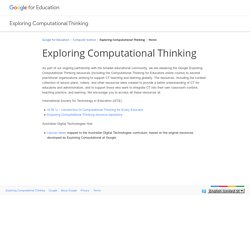
CT is essential to the development of computer applications, but it can also be used to support problem solving across all disciplines, including math, science, and the humanities. Students who learn CT across the curriculum can begin to see a relationship between subjects as well as between school and life outside of the classroom. CT involves a number of skills, including: These skills are supported and enhanced by a number of dispositions or attitudes that include: Confidence in dealing with complexity Persistence in working with difficult problems Tolerance for ambiguity The ability to deal with open ended problems The ability to communicate and work with others to achieve a common goal or solution. 40 Coding & Computer Science, Assessment & Data Resources. Did you know that Cause + Code = The New Impact Formula?
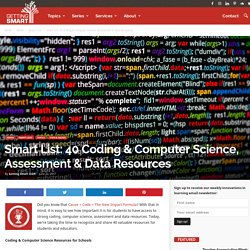
4 Early Learning Strategies for Developing Computational Thinking Skills. As our technologies have rapidly developed and manipulating those technologies has emerged as a key college- and career-ready skill, teaching students how to program, question, and manipulate digital devices has become commonplace in our schools.

But coding is the application of learning. Before students can effectively perform these tasks, they must understand the concepts behind that application. Computational Thinking is the prerequisite skill for understanding the technologies of the future. It is a thought process, rather than a specific body of knowledge about a device or language. Computational thinking is often associated with computers and coding, but it is important to note that it can be taught without a device. For that reason, computational thinking can be a part of any classroom, including the classrooms of our youngest learners in the primary grades. Code design magazine 002. Code design magazine 001. APCSP Course and Exam Description 11 16. Draft 1 - ISTE Standards for Computer Science. Computer Science Curriculum+PD Matrix.
Coding and STEM Curriculum. My school added a K-12 Computer Science Curriculum; your school should too. ECS v8.0 Final single pgs, smaller file. Curriculum – Exploring Computer Science. As you read through the ECS units in more detail, look for our three strands: CS Concepts Coursework focuses on both computer science content and computational practices, and units utilize a variety of tools and platforms.
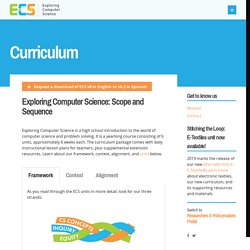
Inquiry An inquiry-based approach to teaching and learning frames the instructional design of the curriculum. Equity. Article Skip Coding, Teach Data Science. Computer programing can be a valuable part of the K-12 curriculum.
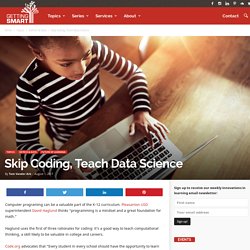
Pleasanton USD superintendent David Haglund thinks “programming is a mindset and a great foundation for math.” Haglund uses the first of three rationales for coding: it’s a good way to teach computational thinking, a skill likely to be valuable in college and careers. Code.org advocates that “Every student in every school should have the opportunity to learn computer science.” Let’s call this the access and equity argument. Computer Science programs to support and encourage students. Start Your Techdegree. Start building your future for $199/month © 2019 Treehouse Island, Inc.

Discover your pathway Start Your Free Trial →FAQ Designed for true beginners We believe anyone can learn to code, no matter your background or experience level. Guided learning paths. Coursera. Nanodegree Programs. Certifications. Courses. Beauty and Joy of Computing. In this course, you will create programs using the snap programming language, you will learn some of the most powerful ideas of computer science, you will be creative, and you will discuss the social implications of computing, thinking deeply about how you can be personally active in promoting the benefits and reducing the possible harms. These are the minimum specifications for running Snap!
Units 1-6 cover all of the AP CSP curriculum framework. You are ready for the exam. Units 7 and 8 focus on recursion, a beautiful and powerful CS idea that goes beyond the AP CSP Framework and exam. These units are perfect to enjoy after the exam. UC Davis Center for Integrated Computing and STEM Education » Computer Science for All. (The first program hello.ch in Ch, the simplest possible coding in text-based programming languages) The C-STEM Math-ICT Curriculum provides K-12 students with up to 13 years of hands-on integrated math and computer science education with coding in Blockly and Ch/C/C++.
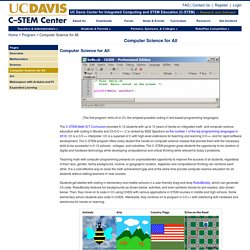
C is ranked by IEEE Spectrum as the number 1 of the top programming languages in 2016. Ch is a C/C++ interpreter. Code HS Course Catalog. Code.org CS Principles 2018. Units Unit 1 - The Internet What can be represented with a single bit and how do we get a single bit of information from one place to another?
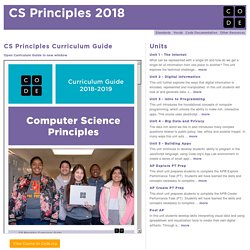
This unit explores the technical challenge... More Unit 2 - Digital Information This unit further explores the ways that digital information is encoded, represented and manipulated. Unit 3 - Intro to Programming This unit introduces the foundational concepts of computer programming, which unlocks the ability to make rich, interactive apps. Code.org CS Discoveries 2018. Unit 1 - Problem Solving The Problem Solving unit is a highly interactive and collaborative introduction to the field of computer science, as framed within the broader pursuit of sol... More Unit 2 - Web Development In the Web Development unit, students are empowered to create and share the content on their own web pages.
They begin by thinking about the role of the web,... Google CS First. CS50's AP® Computer Science Principles. Digital Promise. Robotics Academy - Carnegie Mellon Robotics Academy. Khan Academy. Coding Adventure.